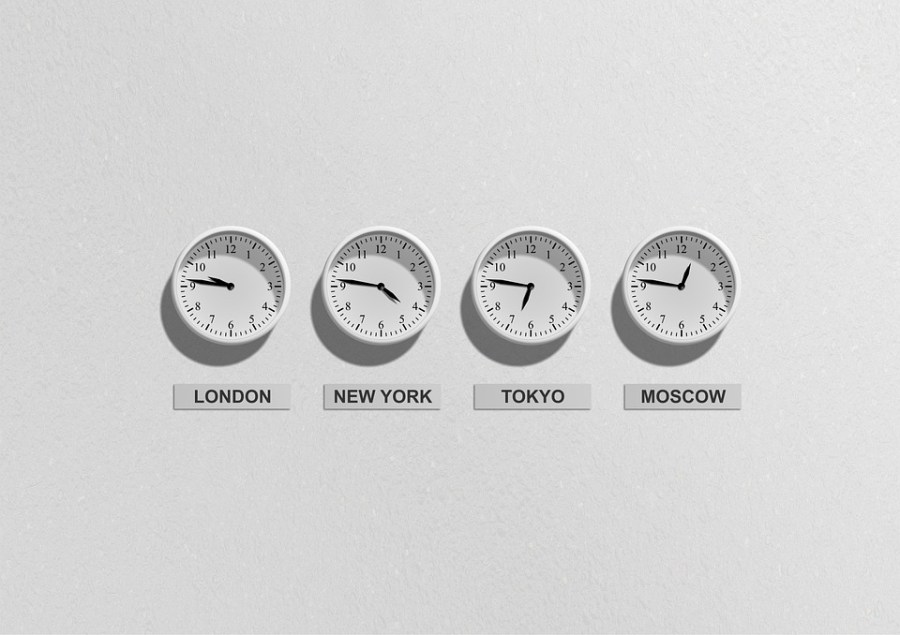
If you board a plane in New York at 3 p.m. and head west, you land in San Francisco at 6:40 p.m. despite the fact that you were in the air for almost seven hours. As you crossed the country, you went back in time—or so it seems. In a way you did. During your flight, you went from one time zone into another. To understand how this works, you need to know how to convert between time zones.
Understanding Time Zones
When people talk about time zones, they’re referring to the way people adjust the clock as they move toward or away from Coordinated Universal Time (UTC). Time advances one hour for every 15 degrees east you move from the Prime Meridian in Greenwich, London. Each one hour increment represents a time zone. When you arrived in San Francisco at 6:40 p.m., it was also 9:40 p.m. on the New York time clock.
Why Did Countries Start Using Time Zones?
Time zones are a relatively recent invention. People used to tell time by the position of the sun. Each community set the official clock at noon when the sun reached its highest spot in the sky. As a result, noon in Washington, D.C. took place before noon in Chicago.
When people started using the railroad to travel and transport goods across the United States, they found local times confusing. It was difficult to coordinate train schedules. The solution was to divide the country into four time zones: eastern, central, mountain and pacific. Within each region, all the clocks displayed the same time.
Universal Coordinated Time
In 1884, representatives from select countries met at the International Meridian Conference in Washington, D.C. During the conference, the members decided to designate the line of longitude that passes through Greenwich, England, as the Prime Meridian. This imaginary line became the standard for Coordinated Universal Time (UTC).
The world uses UTC to regulate clocks. Some people use the terms Coordinated Universal Time and Greenwich Mean Time (GMT) interchangeably, but they are not exactly the same. UTC is the time standard. GMT is a time zone that includes parts of Europe and Africa.
How Many Time Zones Are in the World?
Since there are 24 hours in a day, it makes sense to have 24 time zones in the world. There are, however, more than 30 time zones across the globe. Some of these time zones have increments of 30 minutes or 45 minutes, but most of them represent one hour.
Time zones don’t follow a straight line from north to south. In some countries, the time zone border follows the country’s political border. Other countries, like China, have only one time zone. If you look at a map of the world’s time zones, you see jagged lines where they adjust to accommodate these countries.
Calculating Time Differences
Calculating time differences is fairly simple and requires basic addition and subtraction. You add as you move east and subtract as you move west. Eastern Standard Time is five time zones west of Greenwich Mean Time, so you subtract five hours from UTC to determine the time in New York. Japan Standard Time is nine time zones east of Greenwich Mean Time, so you add nine hours to UTC to calculate the time in Tokyo.
For example, if you’re in Los Angeles and want to know what time it is in Paris, you count the number of time zones between the two cities. There are nine time zones between them. When it’s 1:00 p.m. in Los Angeles, it’s 10:00 p.m. in Paris. The exception to this is a time zone with a 30- or 45-minute increment.
Daylight Saving vs. Standard Time
Benjamin Franklin came up with a plan to change time on the clock and move it ahead one hour in the summer. This gave him an extra hour of natural light in the evening, so he wasted less fuel on lighting. More than 100 years later, the United States adopted Daylight Saving Time as a way to conserve energy during World War I.
The United States isn’t the only country to observe Daylight Saving Time. Most countries in North America, Europe and parts of South America and Australia switch to a form of Daylight Saving Time during the summer. This also makes it more difficult to convert between time zones, so many people use a time zone calculator when they need to know what time it is in another part of the world.






